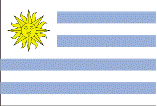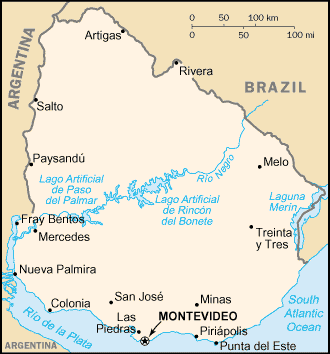|
Uruguay
|

|
Capital: Montevideo
Population: 3,461,734
Brief History of Uruguay:
Uruguay was originally inhabited by the Charua Indians. They resisted conquest by the Spanish for years after Spain came to the land in 1516. In the 16th and 17th century the Spanish began to settle the land and brought cattle to the region, which would later become a major driver to the economy.
Uruguay's capital and largest city today, Montevideo, was founded by the Spanish in the early 18th century as a military base. In 1811, the Uruguayans began their fight for independence behind leader Jose Gervasio Artigas. After some years of fighting, which included being annexed into Brazil and joining a regional federation with Argentina, Uruguay became an independent nation in 1825. Uruguay has since developed into a country with some of the most free political and labor conditions in South America.
The Geography of Uruguay
Total Size: 176,220 square km
Size Comparison: slightly smaller than the state of Washington
Geographical Coordinates: 33 00 S, 56 00 W
World Region or Continent: South America
General Terrain: mostly rolling plains and low hills; fertile coastal lowland
Geographical Low Point: Atlantic Ocean 0 m
Geographical High Point: Cerro Catedral 514 m
Climate: warm temperate; freezing temperatures almost unknown
Major cities: MONTEVIDEO (capital) 1.633 million (2009)
The People of Uruguay
Type of Government: constitutional republic
Languages Spoken: Spanish, Portunol, or Brazilero (Portuguese-Spanish mix on the Brazilian frontier)
Independence: 25 August 1825 (from Brazil)
National Holiday: Independence Day, 25 August (1825)
Nationality: Uruguayan(s)
Religions: Roman Catholic 66% (less than half of the adult population attends church regularly), Protestant 2%, Jewish 1%, nonprofessing or other 31%
National Symbol: Sun of May (a sun-with-face symbol)
National Anthem or Song: Himno Nacional (National Anthem of Uruguay)
Economy of Uruguay
Major Industries: food processing, electrical machinery, transportation equipment, petroleum products, textiles, chemicals, beverages
Agricultural Products: rice, wheat, corn, barley; livestock; fish
Natural Resources: arable land, hydropower, minor minerals, fisheries
Major Exports: meat, rice, leather products, wool, fish, dairy products
Major Imports: machinery, chemicals, road vehicles, crude petroleum
Currency: Uruguayan peso (UYU)
National GDP: $50,910,000,000
** Source for population (2012 est.) and GDP (2011 est.) is CIA World Factbook.
Back to Geography Home Page
